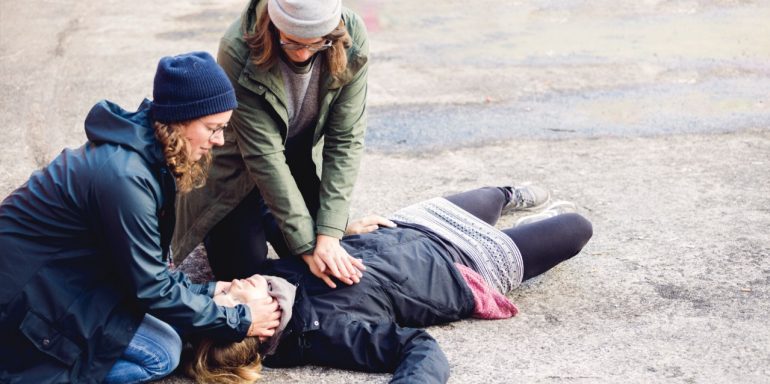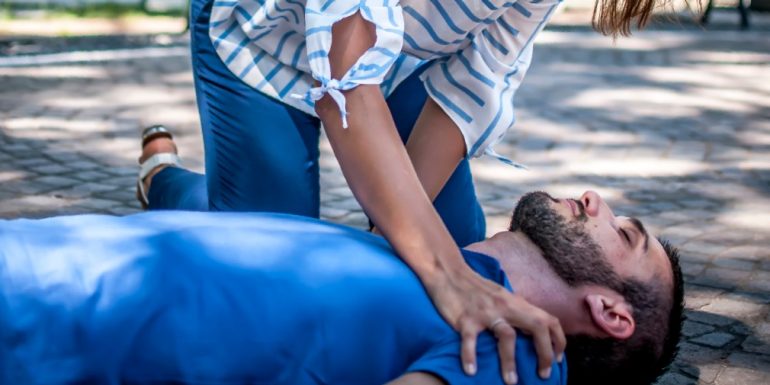
Emergencies involving children: key information
Kids happily go off on little adventures, often oblivious to danger. Learn more about the most common emergencies involving children in and around the home – things every parent should know.
In the bedroom, the kitchen or the garden, potential dangers lurk everywhere: hot stove tops, trailing cables, the neighbour’s pond, or colourful pills and intriguing bottles in the bathroom. Even foods like grapes and raw carrots are a risk if they get stuck in a little one’s throats.
Yet even with the greatest care, you can never entirely prevent children from having accidents. And then there are illnesses that also require first aid. Do you know what to do in these situations? Our tip: attend a baby and child first aid course. You’ll learn techniques like chest compressions and the Heimlich manoeuvre.
In emergencies like poisoning or falls onto the head, you can treat children in the same way as adults. Learn more about the symptoms and causes of the most common emergencies and find out what to do.
How to give emergency first aid to children
In an emergency, stay calm and check that the child is conscious and breathing. If not, call 144 and immediately start resuscitating the child.
- Babies (under one year): hold the child diagonally downwards. Keep their head below their chest. With the flat of your hand, give them five blows between the shoulder blades. If this does not work, perform five chest compressions by pressing two fingers on the centre of their chest, just below the nipples. Repeat until the child spits out the object or you hear them start to cry.
- Young children (over one year): tell the child to cough. If this doesn’t help: with the flat of your hand, give them five blows between the shoulder blades; keep the child bent forwards (for example, over your knee). If this does not work, perform the Heimlich manoeuvre five times.
- After the swallowed object has been dislodged, always seek medical attention.
- Call 144 if the child is at risk of suffocating or if they lose consciousness.
How to perform the Heimlich manoeuvre
The Heimlich manoeuvre is a life-saving emergency measure for clearing a foreign object from the airways. Here’s how it works:
1. Grasp the person with your arms under their stomach from behind, and form a fist with one hand.
2. Firmly hold your fist with your other hand.
3. Pull both hands back towards you with an upward movement.
Immediately run the burn under water at about 20 degrees for 10 minutes. With infants, young children and if the burns are large, be careful to avoid hypothermia. Cover the burn with a sterile dressing. If medical treatment is necessary, you will need to cover the skin with plastic (household cling film). In the event of burns to the face, genitals, joints and large areas of the body, or if the underlying tissue layer becomes visible, call 144.
Pull out the plug or turn off the electricity supply. If this is not possible, break the contact between the child and the electrical supply using a dry, non-conductive object like wood or leather. Is the child unconscious but breathing? Put them in the recovery position. Have they stopped breathing? Start resuscitation. In either case, always call 144.
Is the child responsive? Take off their wet clothes. Wrap them in a blanket and slowly warm them up then take them to hospital. If they are unconscious, call 144.
Put the child in the recovery position if they are breathing on their own. If they have stopped breathing, immediately start resuscitation.
Croup is an viral infection of the larynx and trachea. It usually starts at night. Typical symptoms are a barking cough, hoarse voice, grating breathing noises and shortness of breath. Try to keep the child calm. Take them outside into the cool night air or to a humid bathroom. If they don’t improve after 15 minutes or if they are not getting enough oxygen, call 144.
A febrile seizure is a fit caused by a fever. It usually lasts less than five minutes. Typical symptoms include loss of consciousness, a stiff body and rhythmic twitching all over the body. Lie the child on a stable surface. Undress them and put them in the recovery position. Take their temperature. Try to bring their fever down, but do not give them anything by mouth while they are unconscious. If the febrile seizure lasts longer than 10 to 15 minutes, call 144.

André Roggli works as the interim head of «Education and Volunteer Management» at the Samaritans Switzerland – a rescue organisation of the Swiss Red Cross. In his position as a first aid training expert, he trains lay people from a wide variety of backgrounds. He regularly provides first aid services in organisations and at events. André Roggli gave the editorial team advice and input for this article.


Newsletter
Find out more about current health issues every month and get all the information you need about our attractive offers from all Helsana Group companies * delivered by e-mail to read whenever it suits you. Our newsletter is free of charge and you can sign up here:
- Ms
- Mr
We did not receive your information. Please try again later.
* The Helsana Group comprises Helsana Insurance Company Ltd, Helsana Supplementary Insurances Ltd and Helsana Accidents Ltd.